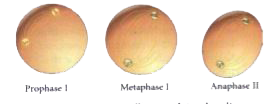Write answers for the following questions
What is crossing over?
Step-by-Step Text Solution:
1. Definition of Crossing Over:
Crossing over is a genetic process that occurs during meiosis, specifically in prophase I, where homologous chromosomes exchange segments of their genetic material.
2. Location in Meiosis:
This event takes place during the prophase I stage of meiosis, which is divided into several phases: leptotene, zygotene, pachytene, diplotene, and diakinesis.
3. Phases of Prophase I:
- Leptotene: Chromosomes start to condense.
- Zygotene: Homologous chromosomes begin to pair up, forming a synaptonemal complex.
- Pachytene: This is the stage where crossing over occurs. The homologous chromosomes are closely aligned and exchange genetic material.
- Diplotene: The synaptonemal complex dissolves, and the homologous chromosomes begin to separate but remain attached at crossover points called chiasmata.
- Diakinesis: The final preparation for separation of homologous chromosomes occurs.
4. Mechanism of Crossing Over:
During the pachytene stage, the synaptonemal complex facilitates the exchange of genetic material between homologous chromosomes, resulting in a recombination of genetic information.
5. Outcome of Crossing Over:
The result of crossing over is the formation of new combinations of alleles, leading to genetic variation in the resulting daughter cells after meiosis. This genetic variation is crucial for evolution and adaptation.
6. Importance of Genetic Variation:
The genetic differences created by crossing over contribute to the diversity of traits in a population, which is essential for natural selection and evolution.
Crossing over is a genetic process that occurs during meiosis, specifically in prophase I, where homologous chromosomes exchange segments of their genetic material.
This event takes place during the prophase I stage of meiosis, which is divided into several phases: leptotene, zygotene, pachytene, diplotene, and diakinesis.
- Leptotene: Chromosomes start to condense.
- Zygotene: Homologous chromosomes begin to pair up, forming a synaptonemal complex.
- Pachytene: This is the stage where crossing over occurs. The homologous chromosomes are closely aligned and exchange genetic material.
- Diplotene: The synaptonemal complex dissolves, and the homologous chromosomes begin to separate but remain attached at crossover points called chiasmata.
- Diakinesis: The final preparation for separation of homologous chromosomes occurs.
During the pachytene stage, the synaptonemal complex facilitates the exchange of genetic material between homologous chromosomes, resulting in a recombination of genetic information.
The result of crossing over is the formation of new combinations of alleles, leading to genetic variation in the resulting daughter cells after meiosis. This genetic variation is crucial for evolution and adaptation.
The genetic differences created by crossing over contribute to the diversity of traits in a population, which is essential for natural selection and evolution.
Topper's Solved these Questions
- CELL CYCLE AND CELL DIVISION BOOK - CENGAGE BIOLOGYCHAPTER - CELL CYCLE AND CELL DIVISION EXERCISE - CONSOLIDATED EXERCISE
62 Videos
- CELL CYCLE AND CELL DIVISION BOOK - CENGAGE BIOLOGYCHAPTER - CELL CYCLE AND CELL DIVISION EXERCISE - OLYMPIAD AND NTSE LEVEL EXERCISES
7 Videos
- CEL: THE BASIC UNIT OF LIFEBOOK - CENGAGE BIOLOGYCHAPTER - CEL: THE BASIC UNIT OF LIFEEXERCISE - CHALLENGING EXERCISE
4 Videos
- CELL: THE BASIC UNIT OF LIFEBOOK - CENGAGE BIOLOGYCHAPTER - CELL: THE BASIC UNIT OF LIFEEXERCISE - MANDATORY EXERCISE (Exercise Set III) (One Mark Questions)
51 Videos
Similar Questions
Write answers for the following questions
What is synapsis?
View SolutionWrite answers for the following questions
What is a cell cycle?
View SolutionWrite answer to the following question :
What is 10% of 10?
View SolutionWrite answers for the following questions
Draw the chromosomes in the diagrams given below:

View SolutionWrite answers for the following questions
Which process is illustrated in the diagram below?

View SolutionWrite answers to the following questions :
What is the HCF of 14 and 126?
View SolutionAnswer the following questions :
What is a polymer?
View SolutionWrite answers for the following questions
Define between mitosis and meiosis.
View SolutionAnswer the following questions :
What is meant by a polymer?
View SolutionWrite answers to the following questions :
Convert 940 into decimal fraction.
View Solution
